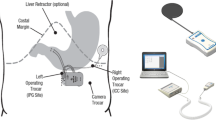Abstract
Background
The Implantable Gastric Stimulator (IGS®), a pacemaker-like device, has been found to be safe and effective to induce and maintain weight loss. The LOSS (Laparoscopic Obesity Stimulation Survey) is a prospective non-randomized trial which enrolled 69 patients involving 11 investigator centers in 5 European Countries. In 19 patients, ghrelin was analyzed.
Methods
Between January 2002 and December 2003, 69 patients (F/M 49/20), mean age 41 years (18–65) underwent IGS implantation. Mean BMI was 41 (35–57), mean weight 115.0 kg (65–160) and mean excess weight (EW) 52 kg (13–89). The IGS was actived 30 days after implantation. In a subset of 19 patients studied further, 0, 6, and 12 months appetite and satiety score were evaluated and 0 and 6 months ghrelin profile was analyzed.
Results
The mean ± standard error %EWL was: 8.6±1.8 at 1 month, 15.8±2.3 at 3 months, 17.8±2.6 at 6 months, 21.0±3.5 at 10 months, and 21.0±5.0 at 15 months. There were no intraoperative surgical or long-term complications. 7 intra-operative gastric penetrations occurred, observed by gastroscopy, without sequelae. 1 patient required a reoperation to remove a retained lead needle. In the subset of 19 patients, appetite was reduced and post-prandial and inter-prandial satiety was increased after IGS implantation. In the 19 patients, despite weight reduction, ghrelin did not increase.
Conclusion
IGS can be implanted laparoscopically with minimal perioperative complications. Appetite is reduced and satiety is increased after the implantation. Ghrelin levels could be one of the mechanisms explaining weight loss and weight maintenance in IGS patients. If weight loss is maintained, IGS could be considered a good option for selected patients.
Similar content being viewed by others
References
Cigaina V, Saggioro A, Rigo V et al. Long-term effects of gastric pacing to reduce food intake in swine. Obes Surg 1996; 6: 250–3.
Cigaina V, Saggioro A, Pezzangora V. The long-term effects of gastric pacing on an obese young woman. Obes Surg 1996; 6:312–3 (abst 41).
Cigaina V, Pinato GP, Rigo V et al. Gastric peristalsis control by mono situ electrical stimulation: a preliminary study. Obes Surg 1996;6:247–9.
Cigaina V, Adler S, Rigo V et al. Implantable gastric stimulator (IGS) as therapy for morbid obesity: equipment, surgical technique and stimulation parameters. Obes Surg 1999; 9: 357–8 (abst 136A).
Cigaina V, Saggioro A, Gracco L et al. Gastric pacemaker to treat morbid obesity — five year experience. Obes Surg 2001; 11: 171 (abst P8).
Favretti F, De Luca M, Segato G et al. Treatment of morbid obesity with the Transcend® Implantable Gastric Stimulator (IGS®): A prospective survey. Obes Surg 14, 2004 666–70.
Busetto L, De Luca M, Favretti F et al. Ghrelin levels before and after weight loss in morbidly obese patients treated by an implantable electrical gastric stimulator. JAMA (in press).
D’Argent J. Gastric electrical stimulation as therapy of morbid obesity: preliminary results of the French study. Obes Surg 2002; 12: 21S-25S.
McCallum RW, Chen JD, Lin Z et al. Gastric pacing improves emptying and symptoms in patients with gastroparesis. Gastroenterology 1998; 114: 456–61.
Cigaina V, Hirschberg A. Gastric pacing and neuroendocrine response: a preliminary report. Obes Surg 2000; 10: 334 (abst 89).
Xing JH, Brody F, Brodsky J et al. Gastric electrical stimulation at proximal stomach induces gastric relaxation in dogs. Neurogastroenterol Motil 2003; 15(1): 15–23.
Ouyang H, Yin J, Chen JD. Therapeutic potential of gastric electrical stimulation for obesity and its possible mechanism: a preliminary canine study. Dig Dis Sci 2003; 48: 698–705.
Chen JD, Qian L, Ouyang H et al. Gastric electrical stimulation with short pulses reduces vomiting but not dysrhythmias in dogs. Gastroenterology 2003; 124: 401–9.
Phillips RJ, Powley TL. Gastric volume rather than nutrient content inhibits food intake. Am J Physiol 1996; 271: R766–R779.
Cummings DE, Weigle DS, Frayo RS et al. Plasma ghrelin levels after diet-induced weight loss or gastric bypass surgery. N Engl J Med 2002; 346: 1623–30.
Favretti F, Cadiere GB, Segato G et al. Laparoscopic adjustable silicone gastric banding (Lap-Band®): How to avoid complications. Obes Surg 1997; 7: 352–8.
Author information
Authors and Affiliations
Corresponding author
Rights and permissions
About this article
Cite this article
De Luca, M., Segato, G., Busetto, L. et al. Progress in Implantable Gastric Stimulation: Summary of Results of the European Multi-Center Study. OBES SURG 14 (Suppl 1), S33–S39 (2004). https://doi.org/10.1007/BF03342136
Published:
Issue Date:
DOI: https://doi.org/10.1007/BF03342136




